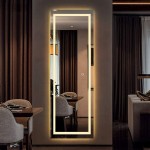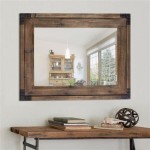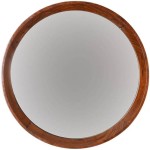Hanging A Heavy Mirror On Drywall Without Studs
Hanging a mirror can significantly alter the aesthetic of a room, adding light and creating a sense of spaciousness. However, the process can become complicated when the mirror is heavy and the desired location lacks the support of a wall stud. Drywall, while suitable for lighter objects, offers limited structural integrity on its own. Consequently, specialized hardware and techniques are necessary to ensure the mirror is securely and safely mounted without risking damage to the wall or the mirror itself.
This article provides a comprehensive guide on how to hang a heavy mirror on drywall without the assistance of wall studs. It details various hardware options, preparatory steps, and installation methods designed to distribute the mirror's weight effectively and prevent it from falling. Proper planning and the selection of appropriate materials are crucial for a successful installation.
Understanding the Limitations of Drywall
Drywall, also known as gypsum board, is a common building material used for interior walls. Its primary component is gypsum, a soft sulfate mineral, encased between two sheets of paper. This construction makes drywall relatively inexpensive and easy to install, but it also limits its load-bearing capacity. Typically, drywall alone can only reliably support items weighing a few pounds. Attempting to hang a heavy mirror directly on drywall using standard nails or screws will likely result in the fasteners pulling out, leading to damage to both the wall and the mirror.
The thickness of the drywall also plays a role in its weight-bearing capacity. Common thicknesses include 1/2 inch and 5/8 inch, with the latter offering slightly more support. However, even 5/8 inch drywall is not designed to bear significant weight without additional support. Therefore, specialized anchors are indispensable when hanging heavy objects, like mirrors, on drywall without studs. These anchors work by distributing the weight over a larger area of the drywall, providing a more secure hold.
Choosing the Right Anchor for the Job
Selecting the appropriate anchor is paramount for a successful and safe installation. Several types of drywall anchors are available, each with its own weight capacity and installation requirements. The weight of the mirror, including the frame, should be carefully considered when choosing an anchor. It is advisable to select an anchor with a weight rating that exceeds the mirror's actual weight by a significant margin for added security. Several popular and reliable options include.
Toggle Bolts: Toggle bolts are among the strongest drywall anchors and are highly recommended for hanging heavy mirrors. These anchors consist of a bolt and a butterfly-like toggle that folds flat to pass through a pre-drilled hole in the drywall. Once inside the wall, the toggle expands, providing a large bearing surface that distributes the weight effectively. Toggle bolts are available in various sizes and weight ratings, making them suitable for a wide range of mirror weights. Installation requires drilling a relatively large hole to accommodate the toggle, so careful measurement is crucial.
Molly Bolts: Molly bolts, also known as expansion bolts, are another strong option for hanging heavy items on drywall. These anchors feature a sleeve that expands behind the drywall when the bolt is tightened, creating a secure hold. Like toggle bolts, molly bolts require pre-drilling a hole in the drywall. As the bolt is tightened, the sleeve expands and grips the back of the drywall, providing a reliable anchor. Molly bolts are available in different sizes and weight ratings, making them versatile for various mirror weights.
Heavy-Duty Drywall Anchors (Self-Drilling): These types of anchors often feature a pointed tip that allows them to be screwed directly into the drywall without pre-drilling in many cases. These are typically made of metal or hardened plastic and a screw is then fastened into these anchors. Their weight ratings and ease of installation make them a popular choice. However, their holding power is generally less than that of toggle bolts or molly bolts, and proper adherence to the manufacturer's installation instructions is crucial.
Wall Anchors (Plastic or Metal): These anchors are inserted into a pre-drilled hole and expand when a screw is inserted, gripping the drywall. While convenient and inexpensive, these anchors are generally suitable for lighter loads and are not recommended for heavy mirrors. Their weight capacity is significantly lower than that of toggle bolts or molly bolts, making them unsuitable for securing heavier items.
When selecting an anchor, it is crucial to consider the weight of the mirror and the manufacturer's weight rating for the anchor. Always choose an anchor with a weight rating that exceeds the mirror's weight by a considerable margin to ensure a secure and reliable installation. It is also advisable to read reviews and seek recommendations from experienced individuals to ensure the chosen anchor is suitable for the specific application.
Preparing for Installation
Before commencing the installation process, careful preparation is essential. This involves gathering the necessary tools, measuring and marking the desired location for the mirror, and verifying that the chosen location is free from any hidden obstacles, such as electrical wiring or plumbing. Proper preparation will minimize the risk of errors and ensure a smooth and safe installation.
Gathering Tools: The following tools will typically be required for hanging a heavy mirror on drywall without studs: a drill with appropriate drill bits (based on the chosen anchor type), a level, a measuring tape, a pencil, a screwdriver (or drill with screwdriver bits), safety glasses, and work gloves. Having all the necessary tools readily available will streamline the installation process and prevent unnecessary delays.
Measuring and Marking: Accurately measuring and marking the desired location for the mirror is crucial for achieving a visually appealing result. Use a measuring tape to determine the desired height and position of the mirror, and then use a level to ensure the mirror will be hung straight. Mark the locations for the anchor holes using a pencil, ensuring they are evenly spaced and aligned with the mirror's mounting hardware. Double-check the measurements to ensure accuracy before drilling any holes.
Locating Obstacles: Before drilling any holes, it is imperative to check for any hidden obstacles behind the drywall, such as electrical wiring or plumbing. Using a stud finder with AC wire detection capabilities can help identify the presence of electrical wiring. If the stud finder indicates the presence of wiring or plumbing in the desired location, select an alternative spot for hanging the mirror to avoid damage or injury.
Testing Anchor Placement: Before fully committing to placement, consider testing the anchor positioning with a small level. Hold the level to the locations you have marked for the anchor holes, to ensure that these holes are level. If they are not level, then make adjustments before proceeding to drilling holes in your wall. This ensures that when you place the mirror on the wall it will appear straight and balanced.
Step-by-Step Installation Guide
Once the preparatory steps are complete, the installation process can begin. The specific steps will vary depending on the type of anchor being used, but the general principles remain the same. Always follow the manufacturer's instructions for the chosen anchor to ensure a safe and secure installation.
Drilling Pilot Holes: If required by the chosen anchor type, carefully drill pilot holes at the marked locations. Use a drill bit that is the appropriate size for the anchor being used. Drill straight into the drywall, applying gentle pressure to avoid damaging the drywall. If drilling into plasterboard, be mindful of the added fragility of plaster. Clear any debris from the holes after drilling.
Installing the Anchors: Insert the anchors into the pre-drilled holes, following the manufacturer's instructions. For toggle bolts, fold the toggle flat and insert it through the hole, then release the toggle inside the wall cavity. For molly bolts, insert the bolt through the mirror's mounting hardware and then insert the bolt and sleeve into the hole. For self-drilling anchors, screw the anchor directly into the drywall using a screwdriver or drill. After the anchors have been inserted, proceed to the next step.
Securing the Mirror: Align the mirror's mounting hardware with the installed anchors and insert the screws or bolts. Tighten the screws or bolts until the mirror is securely mounted against the wall, but avoid overtightening, as this could damage the drywall or the mirror's frame. Use a level to ensure the mirror is hanging straight before fully tightening the fasteners.
Hanging Wire Check: If the mirror utilizes hanging wire, make sure the wire is taut and properly connected to the frame. If there is any slack or the wire shows signs of wear, the wire should be properly secured or even replaced to ensure that the mirror hangs securely.
Weight Testing the Mirror: After the mirror has been hung up, and after you have tightened all screws and bolts, perform a weight test by gently pressing on the mirror to ensure that the anchors and fasteners are secure. Applying pressure will allow you to be able to notice if it is not adequately attached, or if there are any parts of the mirror that need more support. This step is important, to determine if the mirror is adequately supported. If the mirror feels loose, or wobbly, then tighten the screws and bolts until it feels secure.
By following these steps carefully and using the appropriate hardware, one can successfully hang a heavy mirror on drywall without studs, ensuring a safe and aesthetically pleasing result. It is essential to prioritize safety and always err on the side of caution when dealing with heavy objects and drywall installations.
How To Hang A Heavy Mirror On Drywall Quora

A Better Way To Hang Heavy Mirror Hanging Brackets

How To Hang A Heavy Mirror C R F T

How To Hang A Large Or Heavy Mirror

How To Hanging A Mirror Without Stud Heavy

The Best Trick Tool To Hang Stuff On Drywall And Sheetrock Decor

How To Hang A Heavy Mirror

How To Hang A Heavy Mirror Securely Bob Vila

How To Hang A Heavy Mirror

How To Hang A Heavy Mirror On Drywall








